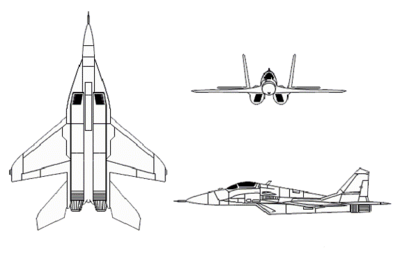Russian Mikoyan MiG-29
Used By US Air Force in "Aggressor" Training
The Mikoyan MiG-29 (Russian: Микоян МиГ-29; NATO reporting name: "Fulcrum") is a fourth-generation jet fighter aircraft designed in the Soviet Union. Developed by the Mikoyan design bureau as an air superiority fighter during the 1970s, the MiG-29, along with the larger Sukhoi Su-27, was developed to counter new American fighters such as the McDonnell Douglas F-15 Eagle, and the General Dynamics F-16 Fighting Falcon. The MiG-29 entered service with the Soviet Air Force in 1983.
While originally oriented towards combat against any enemy aircraft, many MiG-29s have been furnished as multirole fighters capable of performing a number of different operations, and are commonly outfitted to use a range of air-to-surface armaments and precision munitions. The MiG-29 has been manufactured in several major variants, including the multirole Mikoyan MiG-29M and the navalised Mikoyan MiG-29K; the most advanced member of the family to date is the Mikoyan MiG-35. Later models frequently feature improved engines, glass cockpits with HOTAS-compatible flight controls, modern radar and IRST sensors, considerably increased fuel capacity; some aircraft have also been equipped for aerial refuelling.
Following the dissolution of the Soviet Union, a number of successor states have continued to operate the MiG-29; the largest of which is the Russian Air Force. The Russian Air Force wanted to upgrade its existing fleet to the modernised MiG-29SMT configuration, but financial difficulties have limited deliveries. The MiG-29 has also been a popular export aircraft; over 30 individual nations either operate or have previously operated the aircraft to date, India being one of the largest export operators of the type. As of 2013, the MiG-29 is in production by Mikoyan, a subsidiary of United Aircraft Corporation (UAC) since 2006.
In 1997, the United States purchased 21 Moldovan aircraft under the Nunn–Lugar Cooperative Threat Reduction program. Fourteen were MiG-29Ss, which are equipped with an active radar jammer in its spine and are capable of being armed with nuclear weapons. Part of the United States’ motive to purchase these aircraft was to prevent them from being sold to "rogue states", especially Iran. This purchase could also provide the United States Air Force with a working evaluation and data for the MiG-29, and possibly for use in dissimilar air combat training. Such information may prove valuable in any future conflicts and can aid in the design and testing of current and future weapons platforms. In late 1997, the MiGs were delivered to the National Air and Space Intelligence Center (NASIC) at Wright-Patterson Air Force Base in Ohio, though many of the former Moldovan MiG-29s are believed to have been scrapped.
Specifications (MiG-29)

General characteristics
- Crew: 1
- Length: 17.37 m (57 ft)
- Wingspan: 11.4 m (37 ft 3 in)
- Height: 4.73 m (15 ft 6 in)
- Wing area: 38 m² (409 ft²)
- Empty weight: 11,000 kg (24,250 lb)
- Loaded weight: 15,300 kg (33,730 lb)
- Max. takeoff weight: 20,000 kg (44,100 lb)
- Powerplant: 2 × Klimov RD-33 afterburning turbofans, 8,300 kgf (81.4 kN, 18,300 lbf) each
Performance
- Maximum speed: Mach 2.25 (2,400 km/h, 1,490 mph) At low altitude: Mach 1.25 (1,500 km/h, 930 mph)
-
Range: 1,430 km (772 nmi, 888 mi) with maximum internal fuel
- Ferry range: 2,100 km (1,300 mi) with 1 drop tank
- Service ceiling: 18,013 m (59,100 ft)
- Rate of climb: initial 330 m/s average 109 m/s 0–6000 m (65,000 ft/min)
- Wing loading: 403 kg/m² (82 lb/ft²)
- Thrust/weight: 1.09
Armament
- 1 x 30 mm GSh-30-1 cannon with 150 rounds
- 7 Hard points: 6 x pylons under-wing, 1 x under fuselage
- Up to 3,500 kg (7,720 lb) of weapons including six air-to-air missiles — a mix of semi-active radar homing (SARH) and AA-8 "Aphid", AA-10 "Alamo", AA-11 "Archer", AA-12 "Adder", FAB 500-M62, FAB-1000, TN-100, ECM Pods, S-24 rockets, Kh-25, Kh-29
Avionics
- Phazotron N019 Radar, N010 radars
The information contained on this page is unclassified, approved for public dissemination and is released under CC-BY-SA Licensing Agreement.

